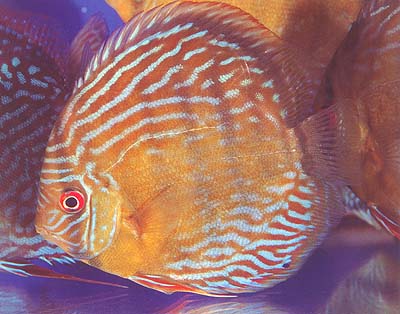Discus - Common
Scientific Name: Symphysodon aequifasciata
Fri, 18th April, 2025 - 8:12 pm GMT
Sponsor Ads:

Alternative Name
Scientific Name: Symphysodon aequifasciataBasic Info
Discus can grow to be quite large, reaching a mature size of six to ten inches. They have round bodies, and are very colorful. However, Discus usually do not gain their beautiful bright colors until they are about three inches in length, unless they are given hormones. These hormoned Discus should be avoided, because they usually are sterile, and their colors fade after a few months of age, leaving them looking bland.
Health
Discus require specific conditions, which can be laborious to maintain. They require soft, acidic water, with a low pH level from 4.7 to 6.8. The water temperature has a narrow and warm range of 82 to 86 degrees. Also, when a tank has Discus, the water needs to be changed regularly, once every two weeks is the minimum, though twice weekly of between 30 & 50% is preferred. It is important to use good conditioners and filtration. This reduces the concentration of nitrite in the water, which stunts the growth of the Discus. They will generally do best in a tank that has reverse osmosis filtered water. Peat filtration is not generally recommended for discus. Turbulent filtration methods should also be avoided, as the Discus does better in calm water. A water hardness of 20 to 110 PPM is recommended. A palate of beef heart, krill, and flake foods should be fed to the Discus. They should not be given any worms, because they contain parasites that will infect the Discus. The discus diets can be quite messy so even a quick vacuum of the gravel every two days can also be beneficial as it is a must that discus have extremely clean water. Discus aren't difficult to keep, it's more that you have to be very dedicated to water changes for them to do well. Also, smaller fish such as guppies or neons should not be kept with larger discus, as they will often eat the neons and guppies. Breeding Breeding and selling the Discus can be profitable, since they are so difficult to breed. The two sexes of the Discus are extremely difficult to distinguish. A higher pH level of 6.5 seems to entice the fish into breeding. Discus will lay carefully lay their eggs an clean stones, and will tend to the fry. It is important not to remove the parents, as the fry will feed of the slime coating on the parents.Habitat
Fresh water fishBehavior
The Discus, or Symphysodon aequifasciatus, is known to many as the "King of the Aquarium". Discus can be a great addition to a tank, given the right conditions for it to exist. They are very colorful, which makes pleasing to watch. They are also a peaceful fish, and will do well with other fish. Discus like to be kept in schools. They are not an overly active fish, and will not harass other fish sharing their space, though they may few smaller fish as food. Other fish it should be kept with include: Cardinal Tetra, Rummy-nose Tetra, Black Neon Tetra, Rafel Catfish, Cory Catfish and Sailfin Pleco. Do not keep Angel Fish with Discus, because they have parasites that can transmit to the Discus, which will make it ill. Also, if a tank has Discus in it, the Discus should be the dominant fish, and should not have to compete for food. The aquarium they are kept in should be lightly decorated with a few large rocks, and a few plants. Some common deformities of Discus include: short fins, and oval shaped body, short spines, short gill covers, and misshapen eyes. When purchasing Discus, look to avoid these deformities, as well as the hormoned ones. Most Discus for sale are breed in captivity. Wild Discus tend to be much less hardy, and often carry diseases.Origin
South AmericaHistory
They are originally found in the Amazon River in South America. Although there are currently five subspecies of Discus, many scientists believe there is only one species, with many different color variations. This theory has recently gained acceptance due to DNA testing.Common Foods
N/ASponsor Ads:
The ship of state is the only ship that leaks at the top. -- Unknown
Discus - Common
Coded by: BGID® | ALL RIGHTS RESERVED Copyright © 2000-2025
Disclaimer | Privacy | Report Errors / Contact | Credits








 President of the United States of America - Real Estate mogul, Pageant owner and now one of the most controversial men in political history.
President of the United States of America - Real Estate mogul, Pageant owner and now one of the most controversial men in political history.  Politician, US Vice President and President of the USA - Joseph Robinette Biden Jr.
Politician, US Vice President and President of the USA - Joseph Robinette Biden Jr.  versus
versus  Russia: 'The Evil Empire'? Are they all that bad or is it just the USA trying to portray Russia as bad because they are a world power with land bigger and a society very different from the USA ideal?
Russia: 'The Evil Empire'? Are they all that bad or is it just the USA trying to portray Russia as bad because they are a world power with land bigger and a society very different from the USA ideal?  Global warming has been in and out as the "latest" hot topic for many years. It is, according to modern scientists, the result of man-made industrial pollutants, clearing forested areas, agriculture, etc. But now they are thinking it started way before the Industrial Revolution...
Global warming has been in and out as the "latest" hot topic for many years. It is, according to modern scientists, the result of man-made industrial pollutants, clearing forested areas, agriculture, etc. But now they are thinking it started way before the Industrial Revolution... 
 Corona virus
Corona virus 
 Users with wide screen monitors can benefit from more content on every page.
Users with wide screen monitors can benefit from more content on every page.